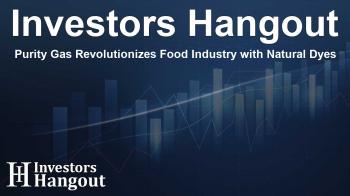Purity Gas Revolutionizes Food Industry with Natural Dyes

Purity Gas Revolutionizes Food Industry with Natural Dyes
Purity Gas is making significant strides in the food industry by facilitating the shift away from artificial food colorings towards natural alternatives. As public demand rises for healthier food options, Purity Gas, known for its expert nitrogen gas solutions, stands at the forefront of this transition.
Responding to Industry Demands
Food manufacturers are taking bold steps to comply with stricter regulations concerning food colorings. Purity Gas is uniquely equipped to provide engineered nitrogen gas generation systems that meet the evolving requirements of the food and beverage sector.
For instance, a leading global food corporation has entrusted Purity Gas with a substantial contract to establish nitrogen gas generation systems across numerous facilities. This project underscores a significant commitment to replace synthetic dyes with natural colorings, adapting to new market demands and ensuring product freshness.
Resolving Oxidation Challenges
The U.S. Food and Drug Administration (FDA) is actively working to eliminate petroleum-based synthetic dyes from the food supply. This initiative is essential as artificial food colorings are prevalent in various products, from breakfast cereals to candies.
These dyes not only provide aesthetic appeal but also play a critical role in preventing oxidation, thereby prolonging the lifespan and stability of the food. However, as manufacturers transition to plant-based color alternatives, they face the challenge of preserving these foods' quality without synthetic additives.
Nitrogen gas serves as an effective solution to this problem. Its properties help replace oxygen in packaging, reducing oxidation and maintaining freshness, hence prolonging the shelf life of food products.
On-Site Nitrogen Generation is Key
At the helm of Purity Gas are co-founders Alan Hopkins and Chris Styles, who emphasize the importance of on-site nitrogen generation in food production processes. With their innovative NITROCENTER® systems, businesses can generate high-purity nitrogen gas on demand, cutting down costs and ensuring reliable supply.
As companies phase out synthetic dyes, they are offered a unique opportunity to adopt nitrogen gas systems that enhance operational efficiency. “On-site generation assures that businesses can meet the growing demand for nitrogen in packaging and preservation effectively,” says Hopkins.
Smart Solutions for Major Brands
The FDA's new regulations set a definitive timeline for the food industry to adopt natural colorings. Major brands are already aligning their operations with this transition, making public commitments to remove harmful additives from their products.
Companies known for their significant market presence like Kraft Heinz, PepsiCo, and Nestle USA are leading the charge. They are not merely responding to regulatory pressures but are proactively improving their product offerings to achieve healthier options.
Expert Guidance Through Transition
Transitioning to natural dyes involves a collaborative effort among multiple departments, including research and development and regulatory affairs, according to Styles. Purity Gas remains committed to supporting manufacturers throughout this shift.
With their comprehensive supply chain and ability to customize systems, Purity Gas ensures that clients receive tailored solutions that meet the unique demands of their operations. The rigidity of traditional liquid nitrogen delivery methods is becoming outdated, and innovative solutions are paving the way forward.
Adopting nitrogen gas generation is more than an operational upgrade; it’s a move towards sustainability. Styles points out that current nitrogen delivery practices present both inefficiencies and environmental concerns, ultimately advocating for an immediate transition to in-house generation systems.
By choosing to generate nitrogen gas on-site, companies will not only modernize their processes but can also address the pressing need for sustainable practices within the food industry.
Frequently Asked Questions
What is Purity Gas's role in the food industry?
Purity Gas provides engineered nitrogen gas generation systems to help food producers transition from synthetic dyes to natural alternatives while enhancing food preservation.
Why are synthetic food dyes being phased out?
Stricter regulations, health concerns, and consumer preference for natural ingredients are driving the phase-out of synthetic food dyes.
How does nitrogen gas help preserve food?
Nitrogen gas replaces oxygen in the packaging of food products, reducing oxidation and maintaining freshness, which extends shelf life.
What technologies does Purity Gas use?
Purity Gas utilizes advanced NITROCENTER® systems to generate high-purity nitrogen gas on-demand, making it efficient and cost-effective for manufacturers.
Which major brands are eliminating synthetic dyes?
Leading companies like Kraft Heinz, PepsiCo, and Nestle USA are actively removing synthetic dyes and are moving towards natural food colorings.
About The Author
Contact Olivia Taylor privately here. Or send an email with ATTN: Olivia Taylor as the subject to contact@investorshangout.com.
About Investors Hangout
Investors Hangout is a leading online stock forum for financial discussion and learning, offering a wide range of free tools and resources. It draws in traders of all levels, who exchange market knowledge, investigate trading tactics, and keep an eye on industry developments in real time. Featuring financial articles, stock message boards, quotes, charts, company profiles, and live news updates. Through cooperative learning and a wealth of informational resources, it helps users from novices creating their first portfolios to experts honing their techniques. Join Investors Hangout today: https://investorshangout.com/
The content of this article is based on factual, publicly available information and does not represent legal, financial, or investment advice. Investors Hangout does not offer financial advice, and the author is not a licensed financial advisor. Consult a qualified advisor before making any financial or investment decisions based on this article. This article should not be considered advice to purchase, sell, or hold any securities or other investments. If any of the material provided here is inaccurate, please contact us for corrections.

